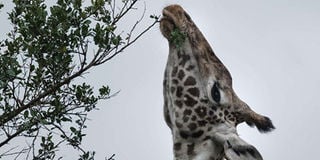The giraffe… going, going… Can we save Maanzoni species?

A Maasai giraffe eats leaves in Nairobi National Park, Kenya, on November 21, 2018. PHOTO | YASUYOSHI CHIBA | AFP
What you need to know:
- The drastic decline of the giraffes that number 30,000 in the wild is due to poaching and loss of habitat, which continues.
- Countries such as Kenya that are signatory to the IUCN are obliged to save the species. Kenya hosts 15 per cent of this population.
In ancient Egypt’s royal tomb of the famous Pharaoh Tutankhamun are images of giraffes nibbling leaves while he sits in state some 3,000 years ago.
Giraffes and elephants, including the rare okapi, lived in the midst of the Egyptians after the forests were plundered to build boats and pyramids for the pharaohs.
Giraffes have globe-trotted the earth since the Miocene era 23 million years ago when their range included Europe and Asia.
“Giraffes appear more frequently than most other animals on rock art,” states David Coulson of the Trust for Africa Rock Art (Tara) that is a digital repository of Africa’s most important prehistoric rock art.
“It is the earliest artistic expressions of humankind, a window on how our ancestors related and interacted with nature and the natural world,” continues Mr Coulson.
"And giraffes are drawn with more care and skill because they were believed to be special and to possess powers, like the power to bring rain.
The biggest rock art image in the world is a 27-foot engraving of a running giraffe in Algeria from about 9,000 years ago. It is one of a herd of nine. The whole panel measures 968 square feet,” said to have been recorded by Tara in 2002.
DRASTIC DECLINE
Today, the gentle giant is found only in sub-Saharan Africa, mostly in zoos and protected areas, and listed on the International Union for Conservation of Nature (IUCN) Red List as ‘Endangered’ or ‘Critically endangered’ depending on which one of the nine subspecies it is.
On the Athi-Kapiti plains 40 kilometres south-east of Nairobi, a herd of Maasai giraffes nibble on the leafy acacias reminiscent of Tutankhamun’s times.
The largest of the giraffe subspecies, the Maasai giraffe is only found in Tanzania and Kenya’s central and southern parts.
As of 2019, the largest of the giraffes is listed ‘Endangered’ on the IUCN Red List.
The drastic decline of the giraffes that number 30,000 in the wild is due to poaching and loss of habitat, which continues.
Countries such as Kenya that are signatory to the IUCN are obliged to save the species. Kenya hosts 15 per cent of this population.
“The giraffe is a keystone species in this ecosystem,” states Dr Jan van Duinen, who arrived in Kenya 40 years ago as a young veterinarian to work on the neighbouring Hopcraft ranch now a conservancy.
KEYSTONE SPECIES
He lost his heart to giraffes and knows most by sight, with detailed records of each of the 150 of the 350 that he’s monitoring.
“The giraffe is a keystone species in this ecosystem, which means it’s the species that has influenced this environment for thousands of years. The plants have adapted to the animals and the environment because wild animals have hormones in their saliva, which activates the growth of the plants,” he says.
He adds: “Without the giraffes browsing on the trees, the trees will grow unchecked and topple over during heavy wind and rain.”
Dr Duinen points to trees that have ‘good browse’ and those that are poorly browsed. “When these poorly-browsed trees topple over, they open the ground.”
This attracts the cattle herders. “The cattle damage the top soil because they are heavy animals with sharp hooves. It’s the beginning of soil erosion. And cattle are not part of this ecosystem. They are exotic animals.”
In contrast to giraffes that are indigenous to Africa, cattle, according to historians, arrived on the continent from the north, most likely from Asia sometime between the seventh and the 10th century.
ROAD SIGNS
Late 2019, members of Maanzoni Owners Association were suddenly informed by Mavoko Municipality of a proposal to change the zoning on Maanzoni for industrial and commercial use along a 10-kilometre stretch bordering the new dual carriageway.
Looking at an aerial map of the land, the 10km strip is the only open corridor left for wildlife like giraffes between Limuru and Machakos.
A century ago, this land boasted a rich concentration of wildlife, like black rhino. Until the 1980s, it had the second largest wildebeest migration after the Serengeti-Mara.
Now it’s a common to see wildlife like hyenas knocked down by speeding vehicles on the new carriageway.
The residents association accuses the National Environment Management Authority (Nema) of not paying attention to the impact of the dual carriageway on the natural corridor.
They’re asking for road signs and bumps for motorists to slow down and avoid knocking down wildlife.
“Most of us landowners bought into a dream when the estate was established,” says a resident. “And that was to live with the wildlife.”
ZONING PLAN
Mr Kanini Musau of Maanzoni Lodge in 2013 is quoted: “We want to keep it this way because so many children never see open spaces like these anymore. The Maanzoni Owners Association is very strict about the land. The building code is very strict; skyscrapers and fencing are not allowed.”
If the Mavoko municipality despite the letters of objection from a majority of the members of the residents association goes ahead with the new zoning plan for industrial and commercial use, it will sound the death-knell for this last remaining population of Maasai giraffes in the Athi-Kapiti plains.
A petition to save the plight of the giraffes of Maanzoni is online. Add your voice to it.




